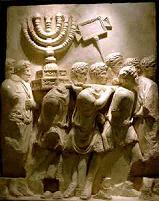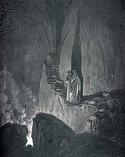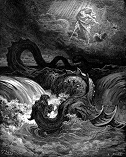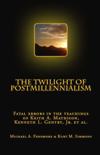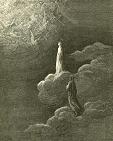Exposition of
Revelation Twenty-Twenty-two
Rev. 20 – Revival of the Persecution, Blessed State of the Martyrs, Resurrection of the Dead
The events of this chapter conclude the judgments begun in chapter 17. The battle of Gog & Magog (vv. 7-10) that brings the defeat of the dragon is the same battle that witnessed the defeat of the harlot in chapter 18, and the beast, false prophet, and kings of the earth in chapter 19. They are the same battle; both describe the persecution under Nero. The martyrs and confessors who perish under Nero and the Jews rest in Paradise pending the general resurrection. Following the defeat of his temporal enemies, Christ vanquishes the last enemy, Hadean death.
Rev. 20:1-3; 7-10 – Binding and Loosing the Dragon (and Beast)
This chapter is the most difficult in the Bible and has given rise to numerous schools of interpretation as students and scholar alike attempt to make sense of its imagery. As with other parts of Revelation, a good deal of the difficulty is owing to the literary structure of the passage, which, if not recognized, creates confusion. John has so composed the chapter that the reign of the martyrs in Paradise appears to be contemporaneous with the binding of the dragon in Tartarus. However, as the martyrs do not perish until the dragon is loosed and the persecution under Nero begins, this obviously cannot be correct. Once this is recognized, the solution becomes relatively simple and everything falls into place.
John sees an angel descend from heaven, having the key of the bottomless pit in his hand. The angel binds the dragon, and casts him into the bottomless pit, and sets a seal over him. After 1,000 years, the dragon is loosed; he goes forth to gather the nations from the four corners of the earth, Gog & Magog, together for battle. They surround the beloved city and camp of the saints, but fire comes down from heaven and consumes them. The dragon is cast into the lake of fire.
The Angel – The time the dragon is bound is contemporaneous with the time of political stability portrayed in chapter seven, where the four angels hold back the four winds of heaven until the remnant can be sealed from the Jews. The angel here is probably best interpreted as Claudius Caesar. In chapter 9, we saw that Nero was the angel who held the keys of the bottomless pit, and loosed the Roman legions to make war against the Jews. Here, however, it is Claudius who controls the keys of the kingdom; he restrains the Roman power, extending the protection of law to the church. Claudius Caesar and Roman law were the “he who restrains” and “what withholdeth” of II Thess. 2:4 that prevented the “mystery of iniquity” (Jewish hatred of the gospel) from breaking out in violence. Claudius’ protection extended even to banishing the Jews from Italy for their continuous riots and tumults against “Chrestus” (Acts 18:2; Suetonius, Claudius XXV, 4).
Roman custom was to allow subjugated nations to keep their own laws. Unless subversive (as astrologers and soothsayers sometimes were), religious habits and customs were guaranteed under the religio licita. On the other hand, although ethnic peoples were permitted to retain their own laws and religious customs, the sovereign power of capital punishment – the ius gladii (“right of the sword”) - was taken away and reposed in the Roman governor. Jews and other ethnic peoples could chastise, fine, and imprison, but they had to obtain permission from Rome before anyone could be sentenced to death. In those days, jurisdiction was based upon ethnicity. The Jews could carry members of their own nation bound to Jerusalem for trial (Acts 9), but could not touch Gentile Christians. Moreover, if one were a citizen of Rome, he could not be bound or scourged without trial and conviction regardless of his ethnicity (Acts 16:37, 38; 22:25, 26). The sum of these factors is that the Jews, who were the only real enemies of the gospel, were extremely limited in their ability to extirpate the church. When Nero came to the throne, he was of tender years, and Seneca and Burris, the tutor and guardians of the emperor’s youth, restrained him. But when he was come of age, Nero threw off all restraint. He slew is wife, brother, and even his mother, and extended his blood lust to Burris, Seneca, Lucan, and many leading citizens of Rome. When rumors that he had ordered the great fire could not be quashed, he found a scapegoat for the crime in the Christians, almost certainly at the suggestion of the Jews.
The 1,000 Years – Greco-Roman notions of Hades had it that the souls of the deceased dwelt in Hades 1,000 years, after which they were born anew to earthly life (see below). This seems to be the meaning of the 1,000 years here. The beast suffered a mortal wound that sent it down in death to the pit in the collapse of the persecution over Stephen (see comments at Rev. 17:7, 8; cf. 13:1-10). Thereafter, the Jews were restrained from persecuting the church all the while Claudius was on the throne. But with the ascension of Nero, the wound would heal and the persecution revive.
Rev. 20: 7-10 - Battle of Gog & Magog
See comments at Rev. 19:11-21.
Rev. 20:4-5 – The Reign of the Martyrs and Righteous Dead
The vision now advances to the time of Nero’s persecution.
“And I saw thrones, and they sat upon them, and judgment was given unto them. And I saw the souls of them that were beheaded for the witness of Jesus, and for the word of God, and which had not worshipped the beast, neither his image, neither had received his mark upon their forehead, or in their hands: and they lived and reigned with Christ a thousand years.”
This is a vision of Hades Paradise. The first group is probably best understood as the righteous dead, consisting of those from Abel and onward who died in a state of grace. Something like this seems to be alluded to by the Lord when he said the “Men of Nineveh shall rise in judgment with this generation, and shall condemn it: because they repented at the preaching of Jonas; and, behold, a great than Jonas is here” (Matt. 12:41). In other words, the righteous would participate in judgment of the wicked and unbelieving, and this even before the judgment of the last day. Thus, John says “I saw thrones, and they sat upon them, and judgment was given to them,” signifying that the righteous dead gave judgment against the persecutors of the church. The second group consists of those who perished (or were perishing) in the persecution under Nero. In a letter recorded by Eusebius, Dionysius of Alexandria alludes to this passage, saying, “the divine martyrs themselves among us, who now are assessors of Christ, and share the fellowship of His kingdom, and take part in His decisions and judge along with Him” etc.[1] From this epistle we learn that the early church believed that the martyrs lived and reigned with Christ in Paradise. Those depicted here have been beheaded for their testimony of Jesus, and for refusing to compromise their witness by obeying the beast. They are the same group described in Rev. 14:13, where the John records a voice saying, “Blessed are the dead which die in the Lord from henceforth; Yea, saith the Spirit, that they may rest from their labors and their works do follow them.” They have been faithful unto death and now reign with Christ. Beheading was an ancient form of execution and dates the martyrs to the time of the apostles. It was also a form of execution sometimes reserved for those of Roman citizenship; non-citizens typically, though not invariably, were crucified, made to fight with wild beasts, or subjected to other forms of torture.[2] Verses tending to corroborate the interpretation that we are dealing with martyrs in Paradise include:
“It is a faithful saying: For if we be dead with him, we shall also live with him: If we suffer, we shall also reign with him: if we deny him, he also will deny us: (II Tim. 2:12).
“Be thou faithful unto death, and I will give thee a crown of life. He that hath an ear, let him hear what the Spirit saith unto the churches; He that overcometh shall not be hurt of the second death” (Rev. 2:10, 11).
“To him that overcometh will I grant to sit with me in my throne, even as I also overcame, and am set down with my Father in his throne” (Rev. 3:21).
Each of these promises was made in the context of abiding faithful through persecution, and each has its specific counterpart in the passage before us: immunity to the second death, living and reigning with Christ, seated upon thrones. The specific mention of the “mark of the beast” signifies that they are those who perished under Nero and the Jews, for it was Nero who was equated with the beast that would arise from the bottomless pit and whose name equaled “666” (Rev. 13:18; 17:8-10). Since this persecution does not occur until the beast and dragon are loosed from the pit (Rev. 11:7; 17:8; 20:7-10), their reign with Christ obviously does not begin until the binding of the dragon ends. Hence, two millennial periods are contemplated by the text.
“It must be observed, that two distinct thousand years are mentioned throughout this whole passage. Each is mentioned thrice; the thousand wherein Satan is bound, verses 2, 3, 7; the thousand wherein the saints shall reign, verses 4-6. The former end before the end of the world; the latter reach to the general resurrection.” [3]
The 1000 Years & the 1st Resurrection – The souls in Hades Paradise are characterized as being partakers of the “first resurrection.” Over these, the second death has no power, but they are priests of God, and live and reign a thousand years with Christ. The first resurrection anticipates the second, general resurrection to eternal life. Jesus said,
“Marvel not at this: for the hour is coming, in the which all that are in the graves shall hear his voice, And shall come forth; they that have done good, unto the resurrection of life; and they that have done evil, unto the resurrection of damnation” (Jn. 5:28, 29).
John says the rest of the dead (the wicked), live not again until the thousand years are finished. In reality, these do not “live” at all; they come forth from Hades Tartarus only to go into the lake of fire, which is the second death. Hence, they are a “savour of death unto death;” whereas the righteous are a “savour of life unto life” (II Cor. 2:16). As noted above, the Greeks and Romans believed that the dead lived in Hades 1,000 years after which they were restored to earthly life. In his epic poem, the Aeneid, Virgil causes his lead character, Aeneas, a survivor of the Trojan war and legendary founder of Rome, to descend to the nether world, where his deceased father describes the 1000-year sojourn of the soul in Hades:
Yes, not even when the last flicker of life has left us, does evil, or the ills that the flesh is heir to, quite relinquish our souls; it must be that many a taint grows deeply, mysteriously grained in their being from long contact with the body. Therefore the dead are disciplined in purgatory, and pay the penalty of old evil: some hang, stretched to the blast of vacuum winds; for others, the stain of sin is washed away in a vast whirlpool or cauterized with fire. Each of us finds in the next world his own level: a few of us are later released to wander at will through broad Elysium, the Happy Fields; until, in the fulness of time, the ages have purged that ingrown stain, and nothing is left but pure ethereal sentience and the spirit’s essential flame. All these souls, when they have finished their thousand-year cycle, God sends for, and they come in crowds to the river Lethe, so, you see, with memory washed out, they may revisit the earth above and begin to wish to be born again.[4]
Revelation was written to Greek and Latin speaking Gentiles in Asia Minor who would almost certainly have associated the millennia of Revelation twenty with Hades – The dragon symbolically bound in Tartarus for a “thousand years,” whence he is released to persecute anew the church, the martyrs in Paradise where they lived and reigned a “thousand years” pending the general resurrection to eternal life. The connection of the passage with Greco-Roman notions of Hades was even noted by the famous French skepic, Voiltaire:
The belief in this reign of a thousand years was long prevalent among the Christians. This period was also in great credit among the Gentiles. The souls of the Egyptians returned to their bodies at the end of a thousand years; and, according to Virgil, the souls in purgatory were exorcised for the same space of time—et mille per annos.[5]
If a learned skeptic recognized the connection between John’s imagery and ancient notions of Hades, it is difficult to imagine that contemporary Christians of Greek descent could fail to see it also. Indeed, the epistle of Dionysius of Alexandria quoted above stands as testimony that in fact they did.
Rev. 20:11-15 – The General Resurrection – Which Death was the Last Enemy?
The theme of resurrection reaches its apex. Every monarch, when newly crowned, must establish his reign by putting his enemies beneath his feet. Thus, as Christ entered upon his reign of earth, he put down his immediate enemies. The last enemy was death (I Cor. 15:26). The critical issue here is what death? The basic assumption of many would likely be that physical death is intended. The only way for this to occur would be for earthly history to end, or be reversed to conditions that prevailed in the garden. However, chapters 21 and 22 show that earth’s history continues after the resurrection and, moreover, that the wicked are present (Rev. 21:8, 25-27; 22:15). Thus, although specific resurrection may entail the end of physical death for the actual recipient, the general resurrection did not terminate physical existence or physical death for all men for all time. Thus, the question still remains what death was defeated at the general resurrection?
There are at least five “deaths” known to scripture. These are 1) moral/spiritual; 2) legal/juridical; 3) bodily/physical; 4) Hadean; and 5) eternal. The general resurrection consisted in raising from Hades all who had suffered physical death or, without experiencing death, had been translated there. Thus, the last enemy was Hadean death. Hades was the last thing separating the saints from the immediate presence of God. The blood of Christ purchased man’s acquittal and redemption and opened the way legally and juridically back into fellowship with God. But Hades still remained to surrender up its inmates so that man could enter the presence of God actually and spatially. The apostle Paul thus states: “O death, where is thy sting? O Hades, where is thy victory? The sting of death is sin, and the strength of sin is the law” (I Cor. 15:55, 56). Christ triumphed over the law of sin and death in his cross (Col. 2:13-15);[6] he vanquished death and Hades by the power of his resurrection. Jesus told the churches “I am he that liveth, and was dead; and, behold, I am alive for evermore, Amen: and have the keys of Hades and of death” (Rev. 1:18). The gates of Hades would not prevail against Christ’s church (Matt. 16:19). At the general resurrection, Hadean death was cast into the lake of fire and forever destroyed (Rev. 20:14). Now, to be absent from the body is to be present with the Lord (II Cor. 5:6, 8). At death, rather than being “gathered unto our fathers” in Sheol or Hades, we are caught up together with them to meet the Lord in the air. “And so shall we ever be with the Lord” (I Thess. 4:17). No words could ever offer greater comfort or hope!
Rev. 21: - The New Heavens and Earth
From the time of the fall, civilization had carved a channel that found the wicked ever in power and oppressing the saints of God. The old heavens and earth were thus marked by socio-political conditions adverse and oppressive toward God’s people. The advent of the Messiah promised to change all this and rescue the saints from their enemies’ hands. Civilization would take a new course, in a new channel carved by the gospel of Christ. The world that had been under the dominion of the saints’ enemies is now under subjection to Christ who rules the nations with a rod of iron, shattering to pieces those that refuse and rebel. John thus see a “new heavens and earth.”
No more sea - Seas are natural boundaries, separating men and nations. In Revelation, the sea has especial reference to the Gentiles (“peoples, multitudes, nations, and tongues” Rev. 17:15). The absence of the sea in the new earth probably points to the fact there is no longer any distinction between Jew and Greek. The Old Testament was marked by its particularism; it was made with the lineal descendants of Abraham who were hemmed in with all manner of laws to keep them separate from the nations and preserve a righteous seed in the earth, until the advent of Christ. But Christ having overcome the world, the gospel call was sent into all the earth. The appeal is universal; all are called to faith and repentance. All approach the throne of grace on equal terms.
No more death, sorrow, or crying – This should be understood in a relative, not absolute sense. The source of this language is Isaiah, where the prophet used it to describe the restoration from captivity and how God would ransom them from the power of the oppressor (Isa. 25:1-8; 35:10; 51:11). The “veil of death covering all peoples” (Isa. 25:7, 8) probably described Assyria and Babylon, which swallowed up the nations like death itself. However, God would ransom them from the power of the Assyro-Babylonian grave, and give political resurrection to the captive nation (Ezek. 37; Hos. 13:14). Applying Isaiah’s usage to the present case, the sorrows, crying, and death associated with the time of persecution and oppression by their enemies (Nero and the Jews) would be wiped away. God would give beauty for ashes, and the oil of joy for mourning. However, it is clear that Isaiah’s prophecy had a plenior sensus (Latin, fuller meaning), and looked beyond historical circumstances on earth, to the happy estate of the saints in heaven where death will be no more at all. This is undoubtedly true also of John, for God “hath abolished death and brought life and immortality to light by the gospel” (II Tim. 1:10). Citizenship in the new Jerusalem makes on a putative heir of God. “He that overcometh shall inherit all things; and I will be his God, and he shall be my son” (Rev. 21:7) However, eternal death is not abolished for everyone. The wicked outside the city do not share in benefits of Christ’s redeeming blood; their lot is the lake of fire (Rev. 22:15, 19).
The Bride, the Lamb’s Wife - An angel says to John, “come, I will show thee the bride, the Lamb’s wife” (Rev. 21: 9). John is then taken to a high mountain, where he sees “the great city, holy Jerusalem descending out of heaven from God.” The great city, holy Jerusalem, the bride is set in contrast to the great city, apostate Jerusalem, the harlot. The one was unfaithful and thus cast away and trodden under foot of man; the bride has been faithful and is therefore exalted and glorified. That the city comes down from God, seems to signify that the church was previously merely in a state of betrothal, awaiting the nuptials, but now the marriage is consummated and Christ makes his abode with the bride; he spreads his garment over her and the tabernacle of God thenceforth is with men. The overall imagery is taken from Ezekiel’s vision of “restored Israel” and the temple under “David the Prince.” Ezekiel’s vision is an elaborate and protracted metaphor of Christ and the church reigning over the earth. The vision begins with the political resurrection of Old Testament Israel after the captivity, portrayed by the valley of dry bones (Ezek. 37). This is followed by the appearance of “David their Prince” (Christ), and the eschatological battle of Gog and Magog (persecution under Nero) (Ezek. 38, 39). After the defeat of Gog and Magog, Ezekiel is taken to a high mountain (Zion, the New Testament) where he is shown the frame of a city on the south (the new Jerusalem, the covenantal habitation of the saints). The city contains a temple (the church) from which issue waters (the gospel) that carry life (regeneration) to the world (Ezek. 40-48). Ezekiel’s allegory answers Isaiah’s vision of Jerusalem rejoicing in the new heavens and earth (Isa. 65, 66). The point of both visions is to show the surpassing greatness of the gospel dispensation and the church’s dominion in the new heavens and earth through Christ.
The City’s Gates & Foundations – The city is encompassed by a wall made of precious stone, jasper, clear as crystal. There are twelve gates, to the east three gates, to the north three gates, to the south three gates and to the west three gates. Upon the gates are the names of the 12 tribes of Israel; its foundations bear the names of the 12 apostles of the Lamb (Rev. 21:12-14). This shows that entrance to the city rests upon the teaching and foundation of the apostles and that those entering in are spiritual Israel. The gates are open in all directions because the gospel invitation is universal; the whole family of man is urged to heed the gospel call. “Now therefore ye are no more strangers and foreigners, but fellowcitizens with the saints, and of the household of God; And are built upon the foundation of the apostles and prophets, Jesus Christ himself being the chief corner stone; In whom all the building fitly framed together groweth unto an holy temple in the Lord: In whom ye also are builded together for an habitation of God through the Spirit” (Eph. 2:19-22). The teaching church is the “pillar and ground of the truth” (I Tim. 3:15). Her walls are Salvation and her gates are Praise (Isa. 60:18).
God and Christ, the City’s Spiritual Light – The city as no need of the sun, nor moon, or stars to give it light, for the Lord God and Christ provide the spiritual light by which the saints guide their lives. “I am the light of the world: he that followeth me shall not walk in darkness, but shall have the light of life” (Jn. 8:12).
The Kings of the Earth bring their Glory to the Church – Isaiah said kings would be the church’s nursing fathers (Isa. 49:23). John says, the nations of them that are saved walk in the city’s light and the kings of the earth bring their glory and honor into it. History confirms these prophecies abundantly. Almost from the very beginning of the gospel, earth’s kings and potentates nurtured the church, and brought their glory into it. The Magi from the east and Europe’s’ monarchs in the west have all adorned the church and built up her walls and bulwarks, much as kings before them adorned the Jerusalem temple with gifts and sacrifices.
Rev. 22 – Vision Concludes
Having surveyed the impending events and victory of Christ over his foes, the vision draws to a close.
The Throne of God and the Lamb, the Fount of Eternal Life (v. 1-3)
In the new Jerusalem, John sees the throne of God and the Lamb. From it issue living waters, clear as crystal. On either side of the river upon its banks is the tree of life; the tree is ever-bearing, producing a crop each month; its leaves are for the healing of the nations. The river is the gospel, which waters the tree of life, giving man eternal life and salvation.
They shall see his Face (v. 4) – The fall brought man’s banishment from the presence and fellowship of his Creator; man was driven from the garden; he was estranged from God and became an exile in the earth. Man was like Absolom whom David, for the death of his brother, would not let “see his face” (II Sam. 14:24; cf. II Kng. 25:19; Est. 1:14; Job 13.24). Even in the temple, God was in the Holy of Holies, separate and removed from the worshipper. None could approach except through the sprinkling of blood and the appointed mediator. The stranger that drew night was put to death. However, the veil of separation was rent in twain in the cross of Christ (Matt.:27:51); man can now boldly enter into that which is within the veil, made faultless before his presence by the blood of Christ (Heb. 6:19; 10:19-22; Jude 24). We are no longer servants, but have attained the adoption of sons, are become heirs of the King, and enjoy a “face to face” relationship with God through Christ.
“Behold, I Come Quickly” (v. 7) – The nearness of the events is unequivocally stated. There simply is no credible way to postpone Christ’s coming beyond the generation to which John wrote. The time statements of Christ’s coming and the eschaton are clear and simple. Nowhere is there the least suggestion the second coming was afar off or looked to distant ages, or to our own day. If the imagery is veiled and the symbols difficult (and they are), the time statements are not. It is a fundamental rule of hermeneutics that we interpret writings by what is plain, not what is doubtful or obscure. In this chapter alone, Christ affirms the nearness of his return no fewer than five times (vv. 6, 7, 10, 12, 20). In the opening chapters of the book they are repeated (Rev. 1:1, 3; 2:5, 16; 3:3, 11). In the body of the book they occur again (Rev. 10:6; 16:15). Moreover, these statements are consistent with virtually every time statement that occurs in the gospels and epistles.
· The axe is already laid to the root of the tree (Matt. 3:10)
· You shall not have over the cities of Israel till the Son of man be come (Matt. 10:23)
· There be some standing here that shall not taste of death till they see the Son of man coming in his kingdom (Matt. 16:27, 28)
· This generation shall not pass away till all these things be fulfilled (Matt. 24:34)
· “If I will that he tarry till I come, what is that to thee?” (Jn. 21:22).
· Jesus shall destroy this place and change the customs given by Moses (Acts 6: 14)
· The night is far spent; the day is at hand (Rom. 13:12 )
· The time is short (I Cor. 7:28)
· It is a very little while, and he that cometh shall come (Heb. 10:27)
· Exhort one another daily, and so much the more as ye see the day approach (Heb. 10:25)
· The coming of the Lord draweth nigh (Jm. 5:8)
· The judge is standing before the door (Jm. 5:9)
· The end of all things is at hand (I Pet. 4:7)
· It is the last hour (I Jn. 1:19)
Can Christianity maintain credibility in the face of so many plain statements if it argues Christ has not yet come?
“He that is unjust, let him be unjust still” (v. 11, 12) – These words are given to punctuate the imminence of Christ’s return. His coming would be like a thief and would take men as it found them, to give to every man according as his works should be (cf. Matt. 16:27, 28).
“The Spirit and the bride say, Come” (v. 17) – That the preceding verses did not foreclose repentance while time and life remained is seen by the invitation of the Spirit and bride, urging men to repentance and to accept the gospel call. “And let him that is athirst come. And whosoever will, let him take of the water of life freely.” The invitation is as valid and urgent today as ever it was. Christ died for all; the gospel is freely available to all; and God wants all to be saved. “For I have no pleasure in the death of him that dieth, saith the Lord GOD: wherefore turn yourselves, and live ye” (Ezek. 18:32).
[1] Eusebius, Ecclesiastical History VI, xlii, 5; Loeb ed.
[2] “He accordingly examined them again, beheaded all who appeared to possess Roman citizenship, and set the rest to the beasts.” Eusebius, Ecclesiastical History, V i, 47; Loeb ed.
[3] John Wesley, in loc
[4] Virgil, Aeneid, lines 735-51; C. Day Lewis ed; cf. Plato, Republic, X, 614
[5] The Works of Voltaire, Vol. III, sec. 1 (1764, Philosophical Dictionary, Part I)
[6] The law of sin and death existed in the garden (“in the day thou eatest thereof thou shalt surely die” Gen. 2:17), and it exists today. All who sin (and only those who sin) come under its power and judgment (“the wages of sin is death” Rom. 6:23). Only by participation in the substitutionary death and atoning sacrifice of Christ are sinners acquitted of its sentence.
To receive Kurt Simmons’ e-mail newsletter, The Sword & The Plow, click the Subscribe link:
All rights reserved.
